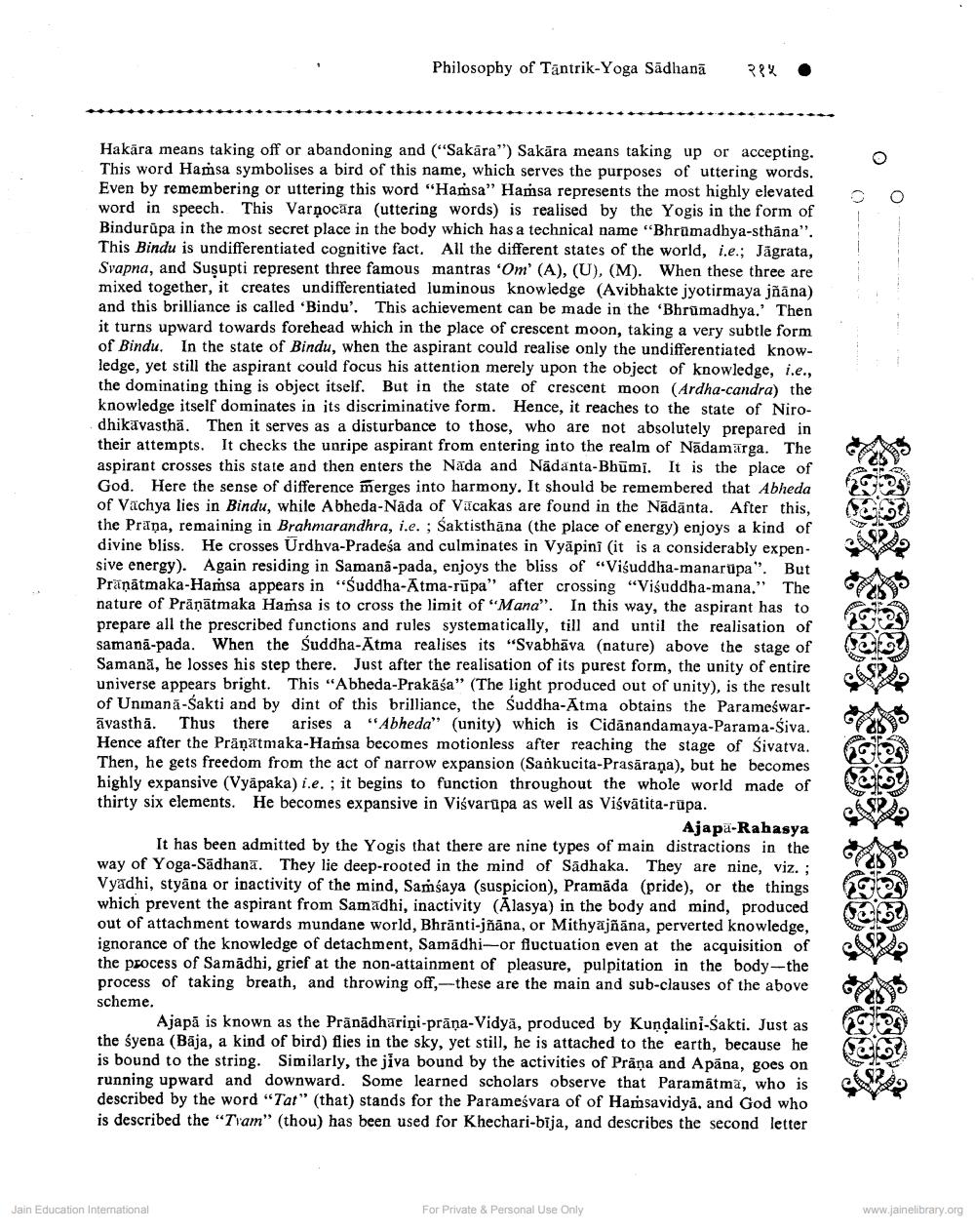Book Title: Philosophy of Tantrik Yoga Sadhna Author(s): Vaishishtha Narain Tripathi Publisher: Z_Pushkarmuni_Abhinandan_Granth_012012.pdf View full book textPage 6
________________ Philosophy of Tantrik-Yoga Sadhana २१५ Hakära means taking off or abandoning and (“Sakāra") Sakāra means taking up or accepting. This word Hamsa symbolises a bird of this name, which serves the purposes of uttering words. Even by remembering or uttering this word "Hamsa" Hamsa represents the most highly elevated word in speech. This Varnocara (uttering words) is realised by the Yogis in the form of Bindurupa in the most secret place in the body which has a technical name "Bhrūmadhya-sthana". This Bindu is undifferentiated cognitive fact. All the different states of the world, i.e.; Jägrata, Svapna, and Suşupti represent three famous mantras 'Om' (A), (U), (M). When these three are mixed together, it creates undifferentiated luminous knowledge (Avibhakte jyotirmaya jñāna) and this brilliance is called 'Bindu'. This achievement can be made in the 'Bhrūmadhya.' Then it turns upward towards forehead which in the place of crescent moon, taking a very subtle form of Bindu. In the state of Bindu, when the aspirant could realise only the undifferentiated knowledge, yet still the aspirant could focus his attention merely upon the object of knowledge, i.e., the dominating thing is object itself. But in the state of crescent moon (Ardha-candra) the knowledge itself dominates in its discriminative form. Hence, it reaches to the state of Nirodhikavasthä. Then it serves as a disturbance to those, who are not absolutely prepared in their attempts. It checks the unripe aspirant from entering into the realm of Nādamarga. The aspirant crosses this state and then enters the Nada and Nādanta-Bhūmi. It is the place of God. Here the sense of difference merges into harmony. It should be remembered that Abheda of Vachya lies in Bindu, while Abheda-Näda of Vacakas are found in the Nādānta. After this, the Praņa, remaining in Brahmarandhra, i.e. ; Saktisthāna (the place of energy) enjoys a kind of divine bliss. He crosses Urdhva-Pradeśa and culminates in Vyāpini (it is a considerably expen sive energy). Again residing in Samana-pada, enjoys the bliss of “Visuddha-manarupa". But Präņātmaka-Hamsa appears in "Suddha-Ātma-rūpa" after crossing “Visuddha-mana." The nature of Pränātmaka Hamsa is to cross the limit of "Mana". In this way, the aspirant has to prepare all the prescribed functions and rules systematically, till and until the realisation of samana-pada. When the suddha-Atma realises its "Svabhāva (nature) above the stage of Samanā, he losses his step there. Just after the realisation of its purest form, the unity of entire universe appears bright. This "Abheda-Prakāśa" (The light produced out of unity), is the result of Unmană-Sakti and by dint of this brilliance, the Suddha-Atma obtains the Parameswarāvastha. Thus there arises a "Abheda" (unity) which is Cidanandamaya-Parama-Śiva. Hence after the Pränatmaka-Hamsa becomes motionless after reaching the stage of sivatva. Then, he gets freedom from the act of narrow expansion (Sankucita-Prasāraņa), but he becomes highly expansive (Vyäpaka) i.e. ; it begins to function throughout the whole world made of thirty six elements. He becomes expansive in Visvarupa as well as Visvätita-rupa. Ajapa-Rahasya It has been admitted by the Yogis that there are nine types of main distractions in the way of Yoga-Sadhana. They lie deep-rooted in the mind of Sadhaka. They are nine, viz.; Vyadhi, styäna or inactivity of the mind, Samsaya (suspicion), Pramāda (pride), or the things which prevent the aspirant from Samadhi, inactivity (Alasya) in the body and mind, produced out of attachment towards mundane world, Bhrānti-jñāna, or Mithyajñāna, perverted knowledge, ignorance of the knowledge of detachment, Samadhi-or fluctuation even at the acquisition of the process of Samadhi, grief at the non-attainment of pleasure, pulpitation in the body--the process of taking breath, and throwing off, these are the main and sub-clauses of the above scheme. Ajapā is known as the Pränadhariņi-prāna-Vidya, produced by Kundalini-Sakti. Just as the syena (Baja, a kind of bird) flies in the sky, yet still, he is attached to the earth, because he is bound to the string. Similarly, the jiva bound by the activities of Prana and Apāna, goes on running upward and downward. Some learned scholars observe that Paramātma, who is described by the word "Tat" (that) stands for the Parameśvara of of Hamsavidya, and God who is described the "Tram" (thou) has been used for Khechari-bija, and describes the second letter Jain Education International For Private & Personal Use Only www.jainelibrary.orgPage Navigation
1 ... 4 5 6 7 8 9
